A direct role for GRASP65 as a mitotically regulated Golgi stacking factor
- PMID: 12839990
- PMCID: PMC165642
- DOI: 10.1093/emboj/cdg317
A direct role for GRASP65 as a mitotically regulated Golgi stacking factor
Erratum in
- EMBO J. 2003 Aug 1;22(15):4026
Abstract
Cell-free assays that mimic the disassembly and reassembly cycle of the Golgi apparatus during mitosis implicated GRASP65 as a mitotically regulated stacking factor. We now present evidence that GRASP65 is directly involved in stacking Golgi cisternae. GRASP65 is the major phosphorylation target in rat liver Golgi membranes of two mitotic kinases, cdc2-cyclin B and polo-like kinases, which alone will unstack Golgi membranes, generating single cisternae. Mitotic cells microinjected with antibodies to GRASP65 fail to form proper Golgi stacks after cell division. Beads coated with GRASP65 homodimers form extensive aggregates consistent with the formation of trans oligomers. These can be disaggregated using purified cdc2-cyclin B1 and polo-like kinases, and re-aggregated after dephosphorylation of GRASP65. Together, these data demonstrate that GRASP65 has the properties required to bind surfaces together in a mitotically regulated manner.
Figures
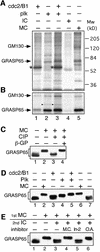
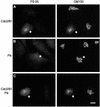

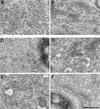
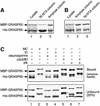
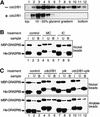
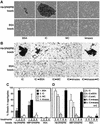
Similar articles
-
Mapping the functional domains of the Golgi stacking factor GRASP65.J Biol Chem. 2005 Feb 11;280(6):4921-8. doi: 10.1074/jbc.M412407200. Epub 2004 Dec 2. J Biol Chem. 2005. PMID: 15576368 Free PMC article.
-
The role of GRASP65 in Golgi cisternal stacking and cell cycle progression.Traffic. 2010 Jun;11(6):827-42. doi: 10.1111/j.1600-0854.2010.01055.x. Epub 2010 Feb 27. Traffic. 2010. PMID: 20214750 Free PMC article.
-
Molecular mechanism of mitotic Golgi disassembly and reassembly revealed by a defined reconstitution assay.J Biol Chem. 2008 Mar 7;283(10):6085-94. doi: 10.1074/jbc.M707715200. Epub 2007 Dec 21. J Biol Chem. 2008. PMID: 18156178 Free PMC article.
-
The multiple facets of the Golgi reassembly stacking proteins.Biochem J. 2011 Feb 1;433(3):423-33. doi: 10.1042/BJ20101540. Biochem J. 2011. PMID: 21235525 Review.
-
Nonredundant Roles of GRASP55 and GRASP65 in the Golgi Apparatus and Beyond.Trends Biochem Sci. 2020 Dec;45(12):1065-1079. doi: 10.1016/j.tibs.2020.08.001. Epub 2020 Sep 4. Trends Biochem Sci. 2020. PMID: 32893104 Free PMC article. Review.
Cited by
-
New structural insights into Golgi Reassembly and Stacking Protein (GRASP) in solution.Sci Rep. 2016 Jul 20;6:29976. doi: 10.1038/srep29976. Sci Rep. 2016. PMID: 27436376 Free PMC article.
-
A Novel Homozygous Frameshift Variant in DYM Causing Dyggve-Melchior-Clausen Syndrome in Pakistani Patients.Front Pediatr. 2020 Jul 16;8:383. doi: 10.3389/fped.2020.00383. eCollection 2020. Front Pediatr. 2020. PMID: 32766185 Free PMC article.
-
Common Assays in Mammalian Golgi Studies.Methods Mol Biol. 2023;2557:303-332. doi: 10.1007/978-1-0716-2639-9_20. Methods Mol Biol. 2023. PMID: 36512224 Free PMC article.
-
Mapping the functional domains of the Golgi stacking factor GRASP65.J Biol Chem. 2005 Feb 11;280(6):4921-8. doi: 10.1074/jbc.M412407200. Epub 2004 Dec 2. J Biol Chem. 2005. PMID: 15576368 Free PMC article.
-
SIRT2 deacetylates GRASP55 to facilitate post-mitotic Golgi assembly.J Cell Sci. 2019 Nov 1;132(21):jcs232389. doi: 10.1242/jcs.232389. J Cell Sci. 2019. PMID: 31604796 Free PMC article.
References
-
- Barr F.A., Puype,M., Vandekerckhove,J. and Warren,G. (1997) GRASP65, a protein involved in the stacking of Golgi cisternae. Cell, 91, 253–262. - PubMed
Publication types
MeSH terms
Substances
LinkOut - more resources
Full Text Sources
Molecular Biology Databases
Miscellaneous

